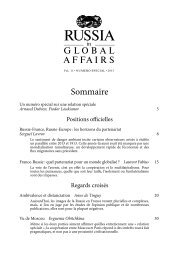said Oleg Dorin of Saint-Gobain. - CCIFR
said Oleg Dorin of Saint-Gobain. - CCIFR
said Oleg Dorin of Saint-Gobain. - CCIFR
- TAGS
- oleg
- dorin
- ccifr
- www.ccifr.ru
Create successful ePaper yourself
Turn your PDF publications into a flip-book with our unique Google optimized e-Paper software.
6<br />
RUSSIA–FRANCE<br />
L’Oreal Adds a French Face<br />
To Kaluga’s Business Hub<br />
THE COSMETICS<br />
GIANT CITES<br />
PRETTY TAX RATES<br />
AND HANDSOME<br />
HELP FROM<br />
OFFICIALS FOR ITS<br />
DECISION TO OPEN<br />
IN THE REGION.<br />
By Alexander Bratersky<br />
VORSINO, Kaluga Region — L’Oreal<br />
Group's factory here is designed<br />
to pump out 120 million cosmetic<br />
products a year, hair dye<br />
kits and bottles <strong>of</strong> shampoo to<br />
be sold in Russia, Ukraine, Kazakhstan and<br />
Belarus.<br />
The factory is no small commitment. The<br />
French cosmetics giant invested 26 million<br />
euros ($37 million) in this Kaluga region plant,<br />
according to L’Oreal figures.<br />
“France is the motherland <strong>of</strong> cosmetics, but<br />
the group had a very good and recognizable<br />
image in Russia,” the general secretary <strong>of</strong> L’Oreal<br />
L’Oreal’s blue-striped factory in the Vorsino industrial park. It makes hair dyes, shampoos and conditioners.<br />
in Russia, Georges Chichmanov, <strong>said</strong> in an interview<br />
at the Kaluga factory.<br />
While Paris is an international center for<br />
beauty products, the Kaluga region is a hub <strong>of</strong><br />
international enterprise within Russia. Joining<br />
South Korean electronics maker Samsung, Swiss<br />
food company Nestle and Swedish automaker<br />
COURTESY OF L’OREAL<br />
Volvo Trucks, L’Oreal is a case study <strong>of</strong> how and<br />
why the region attracts foreign investment: The<br />
local government has created a low income-tax<br />
rate and a business-friendly reputation, drawing<br />
foreign corporations that want to get a foothold<br />
in Russia’s consumer market.<br />
The L’Oreal brand isn’t new to Russian<br />
women. But today, the company, which started<br />
operations in Russia in 1990 through a French-<br />
Soviet joint venture, has become one <strong>of</strong> the most<br />
popular cosmetics brands in the country.<br />
L’Oreal reported revenue <strong>of</strong> about 600,000<br />
euros for 2009, the most recent year for which<br />
the company has disclosed its Russian sales<br />
figures. The Russian market is the company’s<br />
eighth-largest in terms <strong>of</strong> sales, company<br />
managers <strong>said</strong>, and L’Oreal Russia experienced<br />
17.6 percent growth in the first half <strong>of</strong> 2010.<br />
(Figures for 2011 aren’t available yet.)<br />
That’s part <strong>of</strong> a widening market. Overall,<br />
the Russian cosmetic market grew 3 percent to 5<br />
percent last year, and it could increase another 7<br />
percent this year, Renaissance Capital estimated.<br />
According to marketing agency Staraya Krepost<br />
ExpoMediaGroup, the whole <strong>of</strong> Russia’s cosmetics<br />
market reached $11 billion in 2010.<br />
The French cosmetics firm has made successful<br />
inroads. L’Oreal’s advertising catchphrase<br />
— “Because you’re worth it” — has turned into<br />
a household phrase, used by politicians and<br />
comedians alike. In 2004, liberal newspaper<br />
Novaya Gazeta even used the slogan to headline<br />
an article about minimum wage.<br />
COURTESY OF L’OREAL




